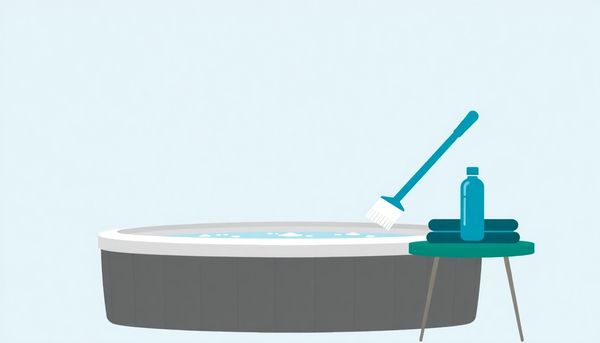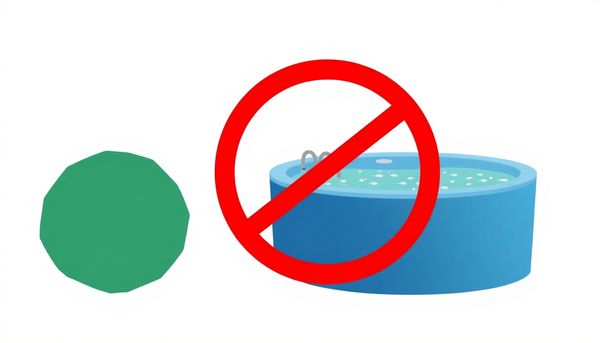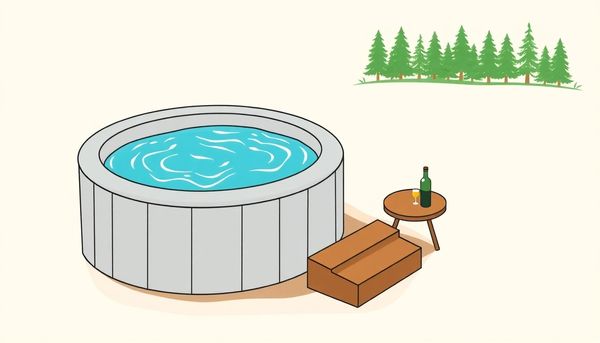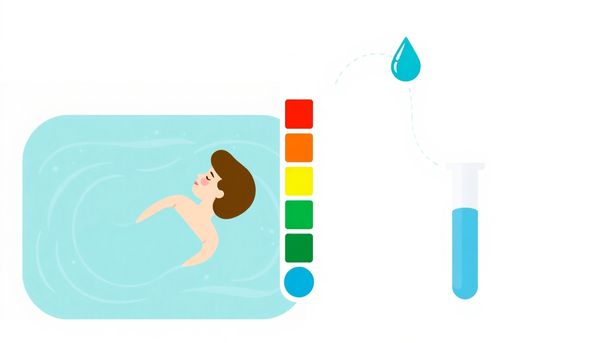Hot Tub Maintenance: Epsom Salt-Free Tips
February 05th, 2024
February 05th, 2024
The allure of a hot tub lies not just in its promise of relaxation but in the subtle art of perfecting the water it holds. Epsom salts, celebrated for their muscle-soothing properties, might seem like a natural addition to enhance your soak. However, the tantalizing idea of blending these salts with your bubbling haven is a slippery slope best avoided. Though Epsom salt sounds like a harmless luxury, introducing it to a hot tub can lead to unexpected complications.
Consider the chemistry at play. Hot tubs are intricate systems that rely on a precise balance of pH and alkalinity, accompanied by vigilant maintenance of pumps and filters. Epsom salts, made of magnesium sulfate, can interfere with this delicate equilibrium, leading to cloudy water and potential damage. A friend once excitedly shared her attempt at an Epsom salt infusion, only to spend an entire weekend wrangling with clogged jets and murky water. Her tale serves as a cautionary reminder that more isn't always better.
Instead of Epsom salts, there are specially formulated hot tub products designed to provide similar benefits without the drawbacks. These alternatives ensure the water remains clear and the equipment unharmed. Embracing these options not only preserves the integrity of your hot tub but elevates the experience, allowing you to truly unwind without the background worry of maintenance mishaps. Enjoying a hot tub should be about tranquility, not troubleshooting.

The allure of slipping into a steaming hot tub, muscles aching for relief, might tempt some to reach for Epsom salt, renowned for its relaxing properties. Yet, this seemingly innocuous action could spell disaster for your hot tub. While Epsom salt works wonders in a regular bath, introducing it to a hot tub is akin to inviting an uninvited guest to a delicately balanced party.
To delve into why Epsom salt becomes a hot tub’s nemesis, consider the chemistry involved. The sulfates and magnesium in Epsom salt wreak havoc on the delicate balance required for hot tub maintenance. These elements can lead to corrosion of metal components, such as heaters and pumps, triggering expensive repairs or even irreversible damage. Additionally, scale buildup from these compounds can clog the plumbing and coat the tub’s surfaces, demanding more frequent and intensive cleaning efforts.
Beyond physical damage, Epsom salt disrupts water chemistry. It can throw off the pH balance, rendering sanitizers like chlorine less effective, thus inviting bacterial growth. High levels of total dissolved solids, introduced by Epsom salt, can make water treatment a chore and may even void your warranty, leaving you without recourse should problems arise.
So, as tempting as the thought may be, it's best to keep Epsom salt out of your hot tub. Explore alternatives specifically designed for spa use, ensuring both your comfort and the longevity of your cherished relaxation space.
Caring for a hot tub involves more than just filling it with water and switching it on. It's about understanding what keeps it in top condition, ensuring each soak is as luxurious as the last. Many are tempted by Epsom salt’s allure, perhaps remembering its soothing touch in a regular bathtub. But a hot tub is no ordinary bath; it requires special care.
Starting with the basics, hot tubs are engineered to maintain consistent water chemistry. This is crucial not only for your safety but for the longevity of the tub itself. Introducing Epsom salt disrupts this delicate balance, leading to corrosion and equipment damage. Early in my hot tub ownership days, I neglected proper maintenance, leading to costly repairs. Trust me, prevention is more affordable than a fix.
Instead of Epsom salt, opt for products specifically designed for hot tubs. Mineral-based spa treatments can offer similar therapeutic benefits without compromising the system. These are formulated with the tub’s intricate mechanics in mind, ensuring relaxation without the worry of damage.
Remember, safeguarding your hot tub is about more than avoiding certain products. Regular maintenance, such as balancing pH and alkalinity, prevents problems before they start. Embrace the alternatives that cater to the needs of your hot tub, ensuring it remains a sanctuary of relaxation for years to come.
If you're looking to enjoy your hot tub without compromising its mechanics, consider exploring safe alternatives to Epsom salt. Many options exist that cater specifically to hot tubs, offering both relaxation and therapeutic benefits without pesky side effects.
Mineral-based spa treatments are a popular choice. These products are crafted to complement your hot tub’s water chemistry. For instance, mineral crystals designed for spa use can enhance your soak by blending elements like magnesium with skin-friendly botanicals, without affecting the pH balance or causing scale buildup. When I first tried them, I was pleasantly surprised by the soothing effect they provided, akin to a mini-vacation in my own backyard.
Aromatherapy crystals are another avenue worth exploring. These are formulated to dissolve easily in hot tub water, infusing it with calming fragrances that can help melt away stress. Unlike essential oils, which can clog filters, these crystal blends are oil-free, ensuring your tub’s system stays in top shape. I’ve found the lavender-scented options particularly effective for a relaxing evening soak.
Hydrotherapy remains a classic choice. Simply enjoying the combination of warm water and targeted jets can do wonders for muscle tension and overall relaxation. By varying the water temperature and jet intensity, you can tailor each session to your needs, making every dip an opportunity to unwind responsibly.
Incorporating these alternatives not only preserves the integrity of your hot tub but also elevates your spa experience to new, serene heights.
In the tranquil world of hot tubs, the last thing you want is a costly repair bill disrupting your serenity. Using Epsom salts in your hot tub can lead to just that, creating a cocktail of issues for your equipment. The metal components in your tub, including the heater and pumps, are particularly vulnerable. Sulfates from Epsom salts can accelerate corrosion, turning sturdy metal into brittle fragments over time. It's not just the metal parts at risk; the plumbing system can suffer too. The magnesium and sulfate ions from Epsom salts encourage scale buildup, a hard, chalky deposit that clogs pipes and reduces water flow.
Imagine soaking in what should be silky, clear water only to find cloudy foam developing around you. This unpleasant sight stems from the oily residue Epsom salts can leave behind, mucking up your filters and diminishing their efficiency. What's more, the delicate balance of water chemistry is thrown off kilter by Epsom salts, making it difficult for sanitizers to do their job effectively. This imbalance can result in bacterial contamination, jeopardizing your health.
Manufacturers design hot tubs with specific water chemistry in mind. Deviating from this with additives like Epsom salts can void warranties, leaving you responsible for expensive repairs. To keep your hot tub running smoothly and your relaxation uninterrupted, it’s best to explore spa-safe alternatives that are designed to work harmoniously with your hot tub’s system. Opt for products that promise the same soothing benefits without the risk, ensuring your oasis remains just that—an oasis.

Guarding your hot tub investment involves more than regular cleaning; it's about making informed choices that ensure longevity. My friend Joe, a fellow hot tub enthusiast, learned this the hard way. Excited by the idea of adding Epsom salt to enhance his soak, he soon faced a hefty repair bill when his tub's metal components began corroding. This served as a vivid reminder to consider the materials interacting with your spa.
The chemistry of your hot tub is delicate. Introducing elements like Epsom salt disrupts the water's balance, leading to equipment damage and potentially voiding warranties. Just as you wouldn't pour sugar into a gas tank, certain additions aren't meant for your spa. Keeping the water's pH and alkalinity in check is crucial; it helps sanitizers work effectively, safeguarding you from harmful bacteria.
Instead, opt for products designed for hot tub use, which offer similar muscular relief without adverse effects. For instance, natural mineral blends or spa-approved crystals can mirror Epsom salt's soothing properties without causing damage. Often, these products are enhanced with aromatherapy benefits, adding an extra layer of relaxation.
Being proactive about what enters your hot tub ensures not just better maintenance but also a more enjoyable, stress-free experience. Embrace solutions that respect the integrity of your spa, providing peace of mind alongside therapeutic benefits.
Stepping into the world of hot tub maintenance unveils a fascinating blend of chemistry and care. While Epsom salt might seem like a soothing addition for sore muscles, it spells disaster for your hot tub’s delicate ecosystem. The magnesium sulfate in Epsom salt, while beneficial for a standard bath, wreaks havoc on hot tub components. Imagine the heartache of finding your hot tub’s metal parts corroded or the heating element failing after a short while. Sulfate ions, the culprits here, don't play well with these systems.
Moreover, Epsom salt can unbalance the water chemistry, turning your oasis into a murky nightmare. It shifts pH levels, which can lead to ineffective sanitizers and increased bacterial risk. Trust me, a bubbling cauldron of germs isn’t what you’re aiming for.
After experimenting with Epsom salt in smaller settings, a friend of mine learned this lesson firsthand. His hot tub became a scene of mysterious foaming and oily residues, not to mention the dreaded scale buildup that clogged his filters. A costly mistake when all was said and done.
Instead of risking damage and voiding warranties, explore alternatives such as mineral-based spa products tailored for hot tub use. They offer similar relaxation benefits without the detrimental effects. So, while Epsom salts work wonders in a bathtub, your hot tub deserves a safer, smarter approach to tranquility.
Before tossing those Epsom salts into your hot tub, consider these safer and equally effective alternatives. Your relaxation oasis deserves the best care, and there are options that won't compromise the mechanics or chemistry of your spa. One such alternative is mineral-based spa treatments. These products are designed specifically for hot tubs, offering relaxation without the risk of damaging the tub’s components. They mimic the soothing effects of Epsom salt but are formulated to maintain water balance and safety.
Hydrotherapy, already a natural benefit of hot tubs, can be enhanced with the use of spa-safe aromatherapy crystals. Infused with natural minerals and botanicals, these crystals dissolve completely, ensuring no residue clogs your system. They transform your soak into a fragrant, stress-relieving experience, much like a day at the spa.
For those seeking scent without the sediment, water-soluble fragrance pods offer a delightful variety of aromas. These pods are crafted to dissolve without leaving behind any oily residue, keeping your hot tub's filter and plumbing free of blockages. They provide a simple way to elevate your hot tub experience, all while respecting the delicate balance of your spa’s water chemistry.
Ultimately, treating your hot tub with the respect it deserves ensures long-lasting enjoyment. By choosing products designed for hot tub use, you keep the water clean, the equipment functioning, and your relaxation uninterrupted.
Maintaining the perfect water chemistry in your hot tub is akin to creating the ideal atmosphere at a cozy gathering—it takes the right mix of elements to ensure everyone stays comfortable and safe. Hot tubs thrive on balance; the equilibrium of pH, alkalinity, and sanitizer levels not only keeps the water crystal clear but also prevents damage to the tub's delicate components.
Start by consistently monitoring your water’s pH level, aiming for a range between 7.2 and 7.8. If the pH drifts too high or low, it can result in itchy skin and eyes, or even worse, corrode metal parts and plumbing. Alkalinity acts as the water’s buffer, preventing drastic pH shifts. It's best to keep it between 80 to 120 ppm (parts per million). I remember realizing the hard way that neglecting these levels led to an unexpected spa shutdown during a much-anticipated holiday weekend. Let's just say, that lesson was learned!
Don’t forget about the sanitizer—chlorine or bromine—which is your best defense against bacteria. A well-balanced sanitizer level (usually between 3 to 5 ppm) staves off contaminants, ensuring every soak is hygienic. Regularly testing with strips or digital testers will help you catch any imbalance before it spirals into a bigger issue, like cloudy water or an unpleasant odor. With a little diligence, your hot tub can remain a place of serene retreat rather than a source of stress.

In the quest for relaxation, there are safer alternatives to Epsom salt when it comes to hot tubs. For those who cherish the soothing embrace of a hot tub session, hydrotherapy offers a splendid way to unwind. The combination of warm water and strategically placed jets works wonders on tense muscles, providing natural relief and comfort without the need for any additives. This tried-and-true method takes full advantage of what hot tubs are designed for—natural relaxation and stress alleviation.
Aromatherapy crystals present another inviting option. These gems are crafted from minerals and botanicals, effortlessly dissolving into the hot tub water. They provide a delightful aroma that enhances the sensory experience without jeopardizing your hot tub’s integrity. With a wide variety of fragrances available, you can easily tailor the ambiance to suit your mood, all while keeping your water chemistry intact.
Mineral spa treatments, specifically formulated for hot tubs, can be a perfect substitute. These treatments are designed to mimic the relaxing properties of Epsom salts but are crafted to be compatible with hot tub systems. They ensure that your relaxation doesn’t come at the cost of expensive repairs.
Ultimately, these alternatives not only protect your hot tub but also enhance your relaxation experience, ensuring each soak is as pleasurable and stress-free as intended.
Selecting the right spa products is crucial for both the health of your hot tub and your personal well-being. The allure of using Epsom salt is understandable due to its muscle-soothing properties, but it's essential to remember that not all beneficial bath products are hot tub-friendly. In my early days of hot tub ownership, I quickly learned the importance of this the hard way. A friend, armed with the best intentions, added a cup of Epsom salt to my hot tub during a backyard gathering. The aftermath was a clogged filter and an afternoon spent with a wet/dry vac instead of enjoying the evening under the stars.
To avoid such mishaps, it's wise to invest in products specifically designed for hot tubs. Many spa products on the market today are engineered to benefit both the user and the tub. These options often contain soothing minerals, botanicals, and other natural ingredients that are safe and effective. They replicate the therapeutic benefits of Epsom salt without the risk of damaging your tub's plumbing or altering its water chemistry.
Consider hot tub aromatherapy crystals, which dissolve fully in water, leaving no residue and offering a range of fragrances to suit your mood. Additionally, mineral-based sanitizers can enhance your hot tub experience without compromising the integrity of your equipment. By choosing compatible spa products, you maintain both the longevity of your hot tub and the quality of your relaxation time.
There’s something comforting about the idea of using nature’s own remedies to soothe our bodies. While Epsom salt and hot tubs might seem like a match made in relaxation heaven, letting them mingle is a recipe for disaster. Yet, nature offers us a rich palette of alternatives that are safe and just as effective at melting away stress.
Consider exploring the benefits of hydrotherapy. This practice, rooted in ancient traditions, uses the pressure and heat from water jets to treat various ailments. It’s all about the synergy between water temperature and movement, which gently eases muscle tension and promotes overall well-being. When I first tried it, I was skeptical, but the relief was undeniable after just a short soak.
Another delightful option is hot tub aromatherapy crystals. These are specifically designed for spa environments and come in a variety of alluring scents like eucalyptus or lavender. They’re formulated without oils, so there’s no risk of clogging filters or altering water chemistry. Once, after a particularly grueling day, I remember adding a handful to my spa—the fragrant steam was a balm to my weary senses.
Finally, the inclusion of water-soluble fragrances can provide a luxurious spa-like experience. These scents are crafted to be gentle on the skin, leaving it soft and refreshed. Each product is a testament to nature’s power to heal and relax, offering a perfect balance of pleasure and practicality. Embrace these natural remedies and let your hot tub time become an oasis of tranquility.
Submerging yourself in the warm, bubbling embrace of a hot tub offers a unique form of hydrotherapy, a time-tested method widely appreciated for its healing properties. This doesn't involve any exotic ingredients but focuses on harnessing the power of water itself. The gentle pressure from the jets coupled with the soothing heat of the water can significantly alleviate muscle tension and soothe aching joints. My friend John, a marathon runner, swears by his post-run routine in his hot tub, using it to treat his tired muscles and reduce recovery time.
Exploring hydrotherapy in your hot tub doesn’t stop at physical relief. Engaging all your senses can lead to a comprehensive wellness experience. For instance, hot tub aromatherapy crystals can elevate your relaxation game. Made from natural minerals and botanicals, these crystals dissolve seamlessly in the water, leaving no oily residue while filling the air with calming scents. I personally enjoy the lavender variant after a particularly hectic day; it’s like a mini-vacation in my backyard.
The beauty of hydrotherapy lies in its simplicity and accessibility. Without needing to alter your hot tub's water chemistry or risk damage to its components, you can regularly enjoy this restorative practice. Whether for easing physical aches, melting away stress, or simply carving out a moment of peace, your hot tub offers a sanctuary of rejuvenation, tapping into the benefits of water as nature intended.

Understanding the importance of water chemistry in a hot tub is akin to knowing the secret ingredient in a cherished family recipe. Just like that perfect blend of spices, maintaining the right balance of chemicals in your hot tub is crucial for a safe and enjoyable soak. When it comes to keeping your hot tub in top condition, the focus should be on pH levels, alkalinity, and calcium hardness. Each of these elements plays a key role in preserving not only the health of your tub but also the safety of its users.
Imagine your pH level as a tightrope walker—too high or too low, and the balance tips towards disaster. Proper pH levels, ideally between 7.2 and 7.8, ensure that your sanitizer works effectively, keeping bacteria at bay. On the other hand, alkalinity acts as the tightrope itself, providing stability and helping to prevent rapid changes in pH. Without the right alkalinity levels, your water chemistry could fluctuate more than the stock market during a recession. A proper range is between 80 and 120 parts per million (ppm).
Another important factor is calcium hardness. Low calcium can cause water to leech minerals from your tub’s components, leading to damage, while high calcium levels result in unsightly scale buildup. Aim for calcium hardness between 150-250 ppm for the best results. By paying attention to these elements, you ensure your hot tub remains a sanctuary of relaxation and not a hub of maintenance headaches.
Every now and then, we encounter the allure of quick fixes that promise relaxation and relief. Just imagine soaking in a blissfully warm hot tub, surrounded by the promise of stress-free muscles and tranquility. It sounds heavenly until you dive into the details of what additives like Epsom salt can actually do to your beloved hot tub. While our eyes light up at the thought of instant muscle relief, throwing Epsom salt into your hot tub mix is like inviting a bull into a china shop.
In my early days as a hot tub enthusiast, I too flirted with the idea of using Epsom salt, enticed by its reputed benefits. However, wisdom came with experience. The repercussions of such a choice are not as soothing. Epsom salt, or magnesium sulfate, is notorious for wreaking havoc on hot tub systems. The ions it introduces can corrode metal parts, leading to leaks and expensive repairs. Over time, scale buildup becomes an unwelcome guest, damaging surfaces and plumbing. The romantic notion of a therapeutic soak quickly turns into a nightmare of maintenance headaches.
Moreover, altering your hot tub’s water chemistry with Epsom salt throws off the delicate pH balance, diminishing the effectiveness of sanitizers. The result? A hotbed for bacteria rather than a serene retreat. This is why most hot tub manufacturers sternly advise against such additives, with warranty refusals standing by for those who ignore the warnings. Keeping your hot tub in top shape means respecting its chemistry and relying on products specifically designed for it. In this case, the path of least resistance is truly the most relaxing.
When the temptation of luxurious relaxation calls, it’s essential to think beyond Epsom salts for your hot tub indulgence. There are alternatives that not only protect your beloved spa but also enhance the overall experience. Imagine stepping into a soak that doesn’t just relax you but also maintains the integrity of your hot tub’s system.
One viable option is the use of spa-specific mineral blends. These are crafted with the hot tub's delicate balance in mind, offering muscle relief and relaxation without the corrosive side effects of Epsom salts. Products like mineral spa crystals dissolve smoothly in water, leaving no trace of residue behind. They often contain magnesium and other soothing elements but are formulated to be non-corrosive and compatible with hot tub environments.
Hydrotherapy remains a cornerstone of hot tub enjoyment. The combination of heated water and strategically placed jets can work wonders on sore muscles and stress levels. Enhancing your experience with water-soluble aromatherapy crystals can add a sensory dimension to your soak. These crystals infuse the water with calming scents, enhancing relaxation without any risk to your tub’s plumbing or filtration systems.
For those with a penchant for scents, exploring water-soluble fragrance pods can be a game-changer. These pods offer a variety of scents, enriched with skin-friendly extracts, ensuring you step out of the tub feeling refreshed and rejuvenated. Always remember, while the allure of Epsom salts is undeniable, respecting the chemistry and mechanics of your hot tub will keep it purring like a contented cat for years to come.
Wading through the aftermath of discovering Epsom salt in your hot tub might feel overwhelming, but don't panic; it’s manageable with a thorough drain and clean. Begin by cutting the power to avoid any electrical mishaps. With the power off, head to the drain valve and connect a garden hose. If you're short on patience, a sump pump can speed up the process. Ensure your hose leads to a safe drainage area.
With the water out, it's time for the elbow grease. Carefully remove the filters and give them a good wash with a filter cleaner; if they’re on their last legs, replace them. Inside the tub, use a non-abrasive cleaner to tackle any residue, paying special attention to jets and crevices. A rinse with clean water ensures no cleaner lingers.
Next, fill your tub by placing the garden hose in the filter well. This helps prevent air locks, ensuring smooth operation later. Once the water reaches the recommended level, reinstall those filters and restore power. Now, introduce the startup chemicals. Run the jets for 15-20 minutes to circulate these, and then test the water. Adjust chemical levels as needed for a balanced environment.
Finally, set the heater to your desired temperature and check that everything—from jets to lights—is running smoothly. With this, your hot tub is ready for relaxation, sans the unwanted side effects of Epsom salt mishaps.

A hot tub, with its soothing jets and warm embrace, is a cherished retreat after a long day. But to keep it inviting and pristine, regular cleaning and maintenance are essential. It might seem like a chore, but once you get the hang of it, it's quite manageable and ensures your tub remains a haven of relaxation.
First things first, safety is paramount. Always start by turning off the power at the circuit breaker. This precaution prevents any mishaps while you're working. Draining the tub is your next step: open the drain valve and attach a garden hose to direct the water to an appropriate area. Alternatively, a sump pump can expedite this process if you're short on time.
Once the water is out, the real work begins. Remove the filters, which are the unsung heroes of your hot tub, catching all sorts of debris. Give them a thorough clean with a filter cleaner, and if they look worse for wear, it might be time for replacements. With the tub empty, use a gentle, non-abrasive cleaner to wipe down the interior surfaces, making sure to reach all the nooks and crannies around the jets.
Rinse the tub thoroughly to ensure no cleaner residue remains. When refilling, place the hose in the filter well to avoid air locks. Once the water level is just right, reinstall the filters, restore power, and add the recommended chemicals. Allow the chemicals to circulate, then test the water to ensure it’s balanced. As a final check, confirm all jets and controls are working perfectly before you dive back into blissful relaxation.
In a world where convenience often trumps caution, it's easy to overlook the hidden dangers in seemingly harmless additions to our leisure activities. Epsom salts, with their soothing reputation, may appear as a tempting addition to your hot tub routine. Yet, these seemingly innocuous crystals can wreak havoc on your spa. The unique water chemistry and intricate plumbing system of hot tubs simply aren't designed to handle such additives.
Take a moment to consider the chemical cocktail that is your hot tub. It's crafted to ensure a delicate balance of pH and alkalinity, crucial for maintaining effective sanitization and a pleasant soaking experience. Introducing Epsom salt disrupts this balance, leading to corrosive damage to metal components like heaters and pumps. Over time, these effects can result in costly repairs and even void warranties, a nightmare for any hot tub owner.
On a personal note, I recall a friend who faced an unexpected repair bill after an innocent attempt to add a spa-like touch with Epsom salts to her hot tub. The result? Corroded gaskets and a malfunctioning heating element. Her experience serves as a cautionary tale, illustrating the potential pitfalls of overlooking manufacturer guidelines.
For those seeking relaxation without risk, there are alternatives designed specifically for hot tub use. Mineral-based products and aromatherapy crystals offer similar therapeutic benefits without compromising your equipment’s integrity. Embracing these spa-safe options ensures you enjoy the tranquility of your hot tub without the unwanted surprises.

In the realm of hot tub maintenance, selecting the right products is as vital as the soothing experience they promise. Rather than risking damage with Epsom salt, which can wreak havoc on your hot tub’s delicate ecosystem, consider specially designed, hot tub-safe alternatives. These products are crafted to harmonize with your hot tub's water chemistry, ensuring relaxation without repercussions.
One such alternative is the use of mineral-based spa products. These are engineered to dissolve completely, offering the therapeutic benefits akin to Epsom salts without the corrosive aftermath. Crafted from a blend of natural minerals, these products are free from oils, ensuring your filters remain clear and effective. I once tried a brand that included a mix of botanical extracts, leaving my skin feeling like I’d just visited a luxury spa.
Aromatherapy crystals are another delightful option. Available in an array of fragrances, these crystals promise a sensory escape while being perfectly safe for your hot tub's mechanics. The scents range from calming lavender to invigorating citrus, each blended with skin-friendly ingredients that enhance your spa experience without compromising the equipment.
Remember, your hot tub is an investment in relaxation. Choosing products specifically formulated for hot tubs not only preserves the life of your tub but also enhances each soak, allowing you to unwind without worry.

This article provided insights into maintaining your pool. Start your pool care journey today!
Want to become a pool maintenance expert? Our free Pool School course covers everything you need to know about pool care. From basic maintenance to advanced troubleshooting, you'll learn how to:
Join over 10,000 pool owners who have already transformed their pool care routine. Get started with our free Pool School course today!